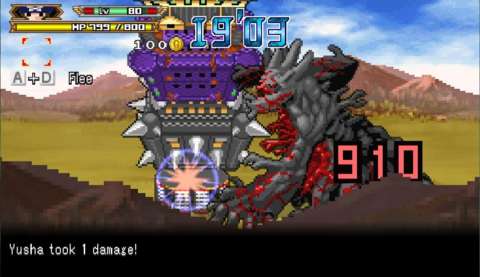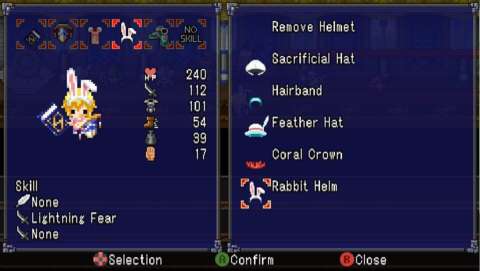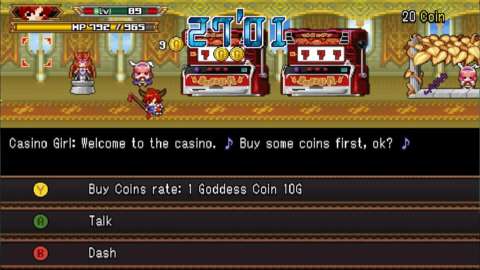The original Half-Minute Hero for the PSP is one of those games that, despite a brilliant concept and critical acclaim, didn't really find an audience, at least not until it was ported to the Xbox 360 and PC at a later date. Half Minute Hero: The Second Coming is a direct follow-up to that game, taking place some time after that game's end. The initial story follows Yusha, a brooding military commander with a mysterious past. During a challenging mission in which the continent is threatened with destruction within an extremely short time frame, he's approached by the world's omnipresent time goddess, who has the power to rewind time in exchange for her favorite thing: cold, hard cash. But Yusha's about to get caught up in something far bigger: an epic time-bending conflict stretching across multiple generations and locations--in 30-second chunks.

The gameplay in The Second Coming remains similar to the original's Hero 30 mode. The game is split up into missions, where you have around 30 seconds to figure out a way to destroy a large enemy that will cause global destruction if the timer runs out. This process is facilitated by progression that distills common tropes to their bare essentials: fighting enemies to gain levels, stopping at towns to get information and supplies, and finding a path to the boss's lair. Given that there's only 30 seconds to accomplish all of this, things have been heavily streamlined: enemy fights involve auto-ramming into foes until somebody dies, character levels skyrocket within seconds, and towns are linear paths that allow you to dash in, get what you need, and dash out. Even so, 30 seconds is a harsh time limit, so you have the ability to pray to statues of the time goddess to reset the clock. But every time you do, she asks for a little bit more cash, making each progressive reset more and more expensive to finance. The game transforms a typically slow-paced genre into an epic race against time, turning genre conventions on their head and making you think and act quickly in order to succeed.
Unlike the original game, which offered multiple game genres (real-time strategy, shooter, tower defense) creatively compressed into thirty-second chunks, The Second Coming is entirely based around the RPG-styled gameplay. The lack of clever gameplay variety compared to its predecessor is one of the biggest disappointments of The Second Coming, and I often found myself wishing I could switch to a different sort of 30-second adventure every so often like I could with the original.

However, the one style of gameplay that is present in The Second Coming is far more engaging and refined here than it was in the original game. There's now an actual overworld to explore between quests, offering optional dungeons, enemy battles, and tons of hidden secrets. Taking a bit of time to poke around between 30-second do-or-die adventures can yield treasures like hidden gear and evil lord medals, which can be exchanged for various unlockable features. Combat--simple though it may be--has also been refined with the addition of super-damaging, auto-activating skills learned from weapons and a stat-altering class-change system.
Quest design, too, benefits greatly from this increased focus, with some creative ideas thrown into the mix. Areas of the map may be destroyed when the timer hits certain points, necessitating a potentially costly time reset to restore things to how they were originally. Defeating giant-sized enemies and obstacles requires the aid of a ridiculous-looking mobile battle fortress you find and continually build upon throughout the game. One of my favorite quests involves you being given an absurd amount of "cursed money" you have to figure out how to waste before time runs out--a choice between blowing it all in an underground casino like a boss or buying individual loaves of overpriced bread to feed to children of a Dickensian orphanage.
As you might suspect from hearing that quest description, The Second Coming incorporates a lot of silliness and humor into its proceedings. The settings--standard fantasy, modernized pseudo-fantasy, and post-apocalyptic fantasy--are inspired by common tropes of JRPG worlds. Every well-worn character arc you can imagine (the obviously-set-to-betray-you party member, the jealous childhood rival, the thief turned ally, amongst many) is present, as are common plot threads (we must prove ourselves worthy of this power we need to defeat the boss!), though with their own goofy little twists to suit the game's frenetic pace. Famous RPG scenes, characters, and concepts are referenced and parodied lovingly, but even concepts outside of RPGs and games are fair game for The Second Coming's delightfully silly story. The game sometimes invests too heavily in its ridiculous narrative, however. There are some genuinely heartfelt moments in the story, but occasionally an overly wordy dialogue sequence leaves you wondering if the writers have started to take their tribute to RPG cliches a little too seriously. (Thankfully, the start button will skip reams of dialogue during almost every part of the game.)

Beyond the main game, The Second Coming introduces new map/quest creation modes and a multiplayer feature. The quest creation tool allows you to develop simple quests and challenges on custom maps for players to download and enjoy in either solo or multiplayer modes. It's a nice way to let player creativity shine, and sharing created content on Steamworks is a breeze, though since this game was ported from an original Japanese PSP release, the actual creation interface itself is a little rough around the edges and not really optimized as well as it could be for a PC. Multiplayer is an absolute blast, allowing up to four players to play through a map and try to hinder each others' progress in defeating the evil lord. The 30-second timer remains and is universal for all players--if one person resets, it's reset for everyone, and if it runs out, all players are penalized. Throw in optional "goddess whims" that have random effects on the map and players and you've got a formula for ever-changing, incredibly fast-paced fun. You can even use your (or others') custom maps to make things even more challenging.
The Second Coming is a delight to play. While the lack of gameplay variety compared to what came before is a definite disappointment, the game is just so outright fun that it's easy to forgive. The sheer joy of fast-smashing adorable little pixel characters against each other while an amazing soundtrack filled with all-star game music composers cheers you to victory against the clock is well worth the price of admission, and the delightful secrets and extras make it an even more appealing package.